In many people’s eyes, the FIFA World Cup 2022 was this golden Belgium generation’s last dance. With players like Man City’s Kevin De Bruyne and Real Madrid’s Eden Hazard reaching the backend of their careers, this World Cup was the last title opportunity for some of Belgium’s greatest footballers. Things could not have gone worse though, and now with the group stage being officially over, the Red Devils are already packing their bags.
Their performances against both Canada and Morocco were equally frustrating, although both had distinct results. The final match of the group stage, against Croatia, was the final nail in Belgium’s coffin. After a frustrating loss to Morocco, Belgium entered the toughest and final match of the group stage with serious danger of elimination. Their worst fears became true and after a 0-0 draw, Roberto Martínez saw his side exit the World Cup prematurely.
The match in itself proved to be a representation of Belgium in this World Cup. With an emotionless and confused feel to it, Belgium’s collective looked far from threatening. Martínez made a few adjustments after their loss to Morocco, especially with the hope of limiting the threat of Croatia’s midfield. Although his side looked organised on the pitch, there was not much more to it. For the majority of the match, they struggled to progress with effectiveness, let alone create quality chances.
However, credit must also be given to Zlatko Dalić’s side. Croatia were extremely organised and successful defensively, seeing out the draw which qualified them for the next stage. They also looked very threatening going forward, but it looked as if they did not want to expose themselves that much. Nonetheless, Dalić saw his side secure qualification to the Round of 16 where they look to make history yet again.
This tactical analysis takes a special in-depth dive into the tactics behind this decisive encounter between Belgium and Croatia. This analysis first looks at Martínez’s strategy coming into this match, and how the Spanish attempted to overload Croatia’s midfield. Additionally, we will explore how Croatia’s defensive tactics rendered Belgium’s possession completely ineffective and secured their qualification.
Lineups
While Croatia came into this match with the same starting XI as their last match, Roberto Martínez made a few changes in his side. While some of these changes had the strategy for this game in mind, they also looked to shake things up after some disappointing individual performances.
For Belgium, Thibaut Courtois was in goal behind Thomas Meunier, Toby Alderweireld, Jan Vertonghen, and Timothy Castagne. In the midfield, Premier League‘s Leander Dendoncker joined La Liga’s Axel Witsel in a double pivot behind Kevin De Bruyne, Dries Mertens, and Yannick Carrasco. Up top, or at least on paper, Leandro Trossard led the line.
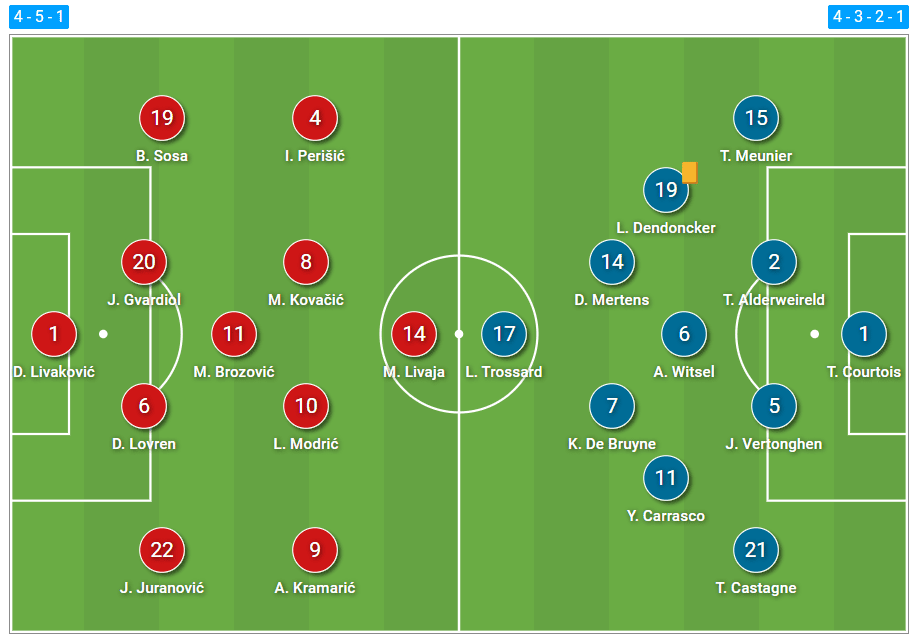
On the other hand, there were no surprises from Dalić. The 56-year-old lined up with Dominik Livaković in goal and Josip Juranović, Dejan Lovren, Joško Gvardiol, and Borna Sosa in the backline. In the midfield, Croatia’s historic trio of Marcelo Brozović, Luka Modrić, and Mateo Kovačić began the match. Finally, the front three consisted of Andrej Kramarić, Marko Livaja, and Ivan Perišić.
Overloading the midfield
Croatia’s midfield trio is undoubtedly the focal point of Dalić’s side. In an attempt to nullify, or at least limit the threat posed by them, Martínez looked to pack the middle of the park. By playing a multi-line structure and creating a numerical superiority in such a key area, Martínez hoped to gain control of the match and equally create and defend with success.
Before understanding how exactly this superiority worked out, it is important to understand how Belgium were structured with the ball. The Red Devils were in their usual 3-4-3 shape, but this was created through asymmetric roles. On the left, Castagne sat lower to form a back three while Meunier pushed high. Further up, on the left, Carrasco remained extremely wide while De Bruyne pushed inside from the right. By coming inside, KDB formed a fluid line of three with Trossard and Mertens.
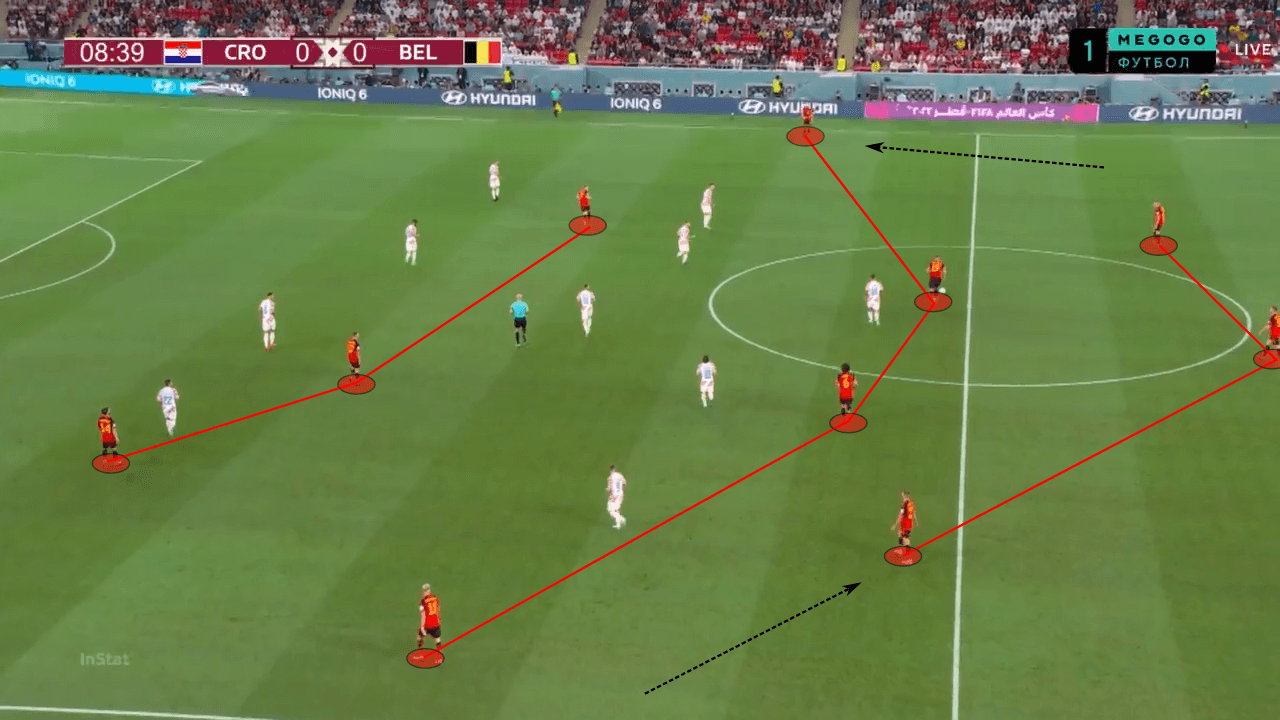
The structure of Croatia’s midfield trio was simply an inverted triangle, with Brozović sitting behind Modrić and Kovačić. On the other hand, Belgium’s front three turned into a triangle with two of the three dropping as advanced midfielders. This naturally created a 2v1 superiority against Brozović as Modrić and Kovačić were busy with Belgium’s double pivot.
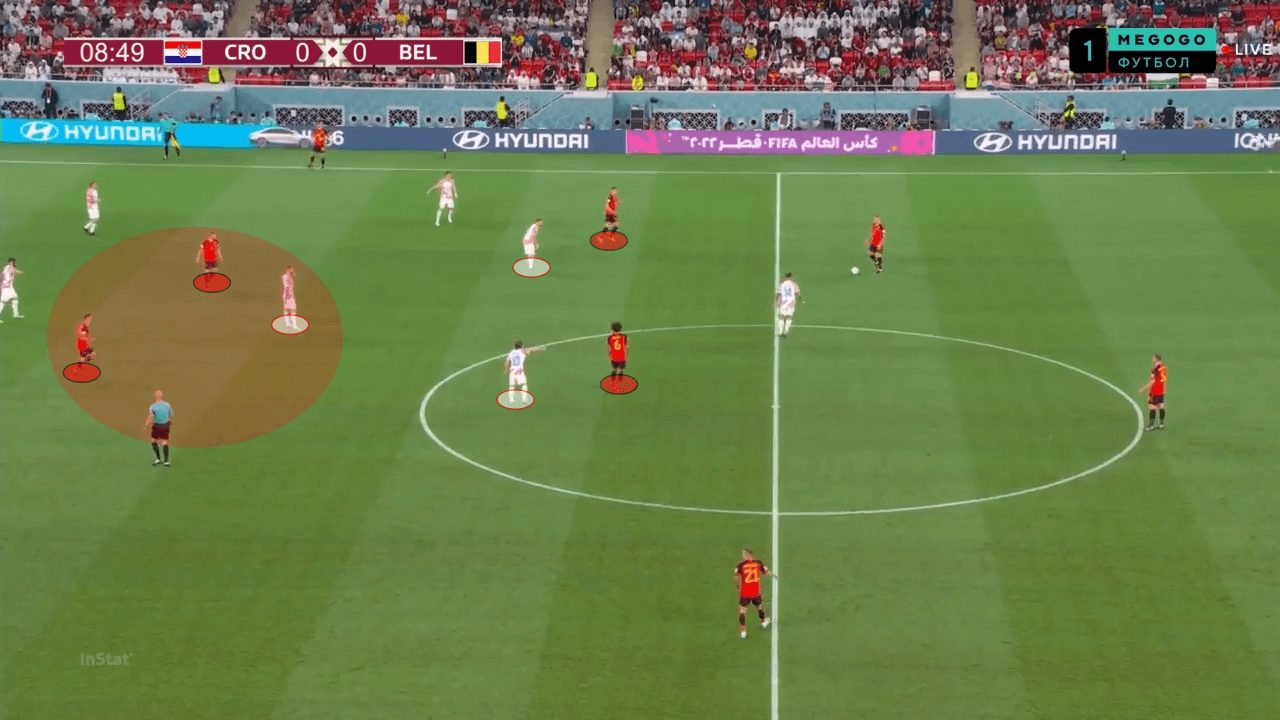
This proved to be extremely effective in the earlier stages of possession, where Croatia’s defensive organisation was vertically stretched. In the segment below, Belgium’s deep-lying double pivot attracts Croatia’s advanced midfielders and leaves a large amount of space for Brozović to deal with. Trossard is the first player to attack this space, and the Inter defensive midfielder quickly follows him.
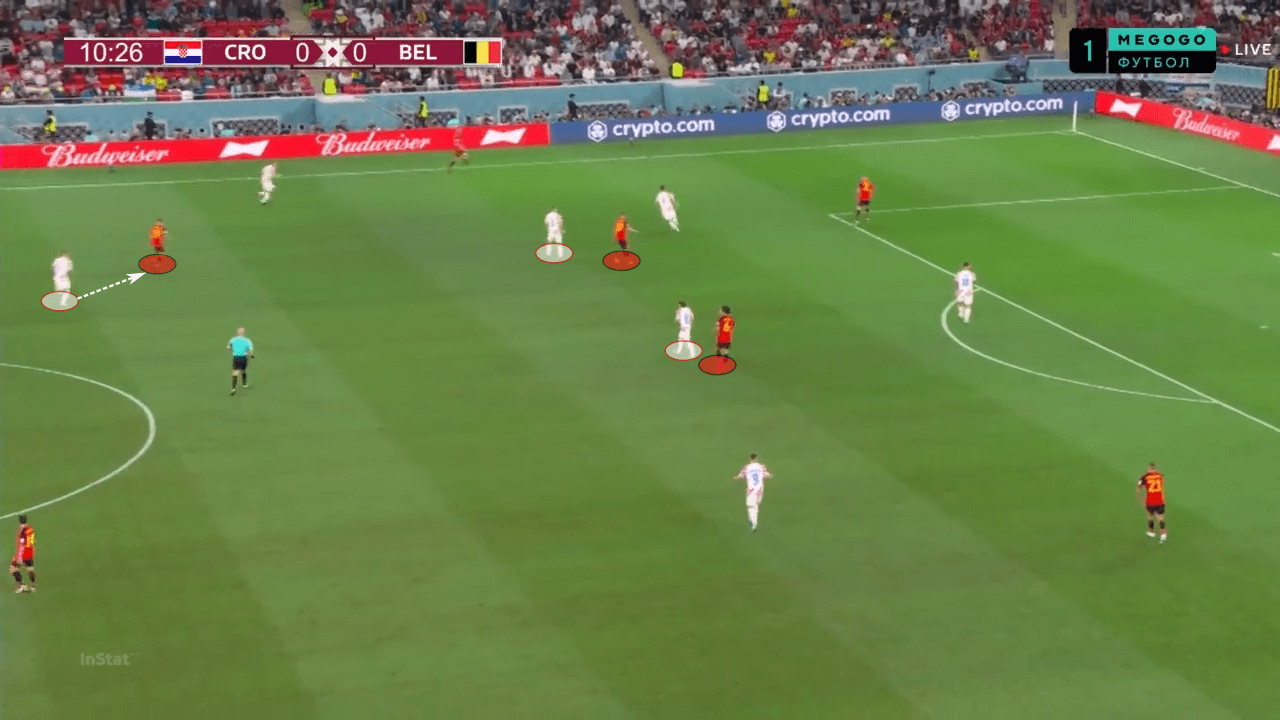
The other advanced midfielder, Kevin De Bruyne, is left to show for the ball between the defensive lines with tremendous freedom. While Belgium were able to find success between the lines in the earlier stages of possession, in Croatia’s half, this proved to be much more difficult.
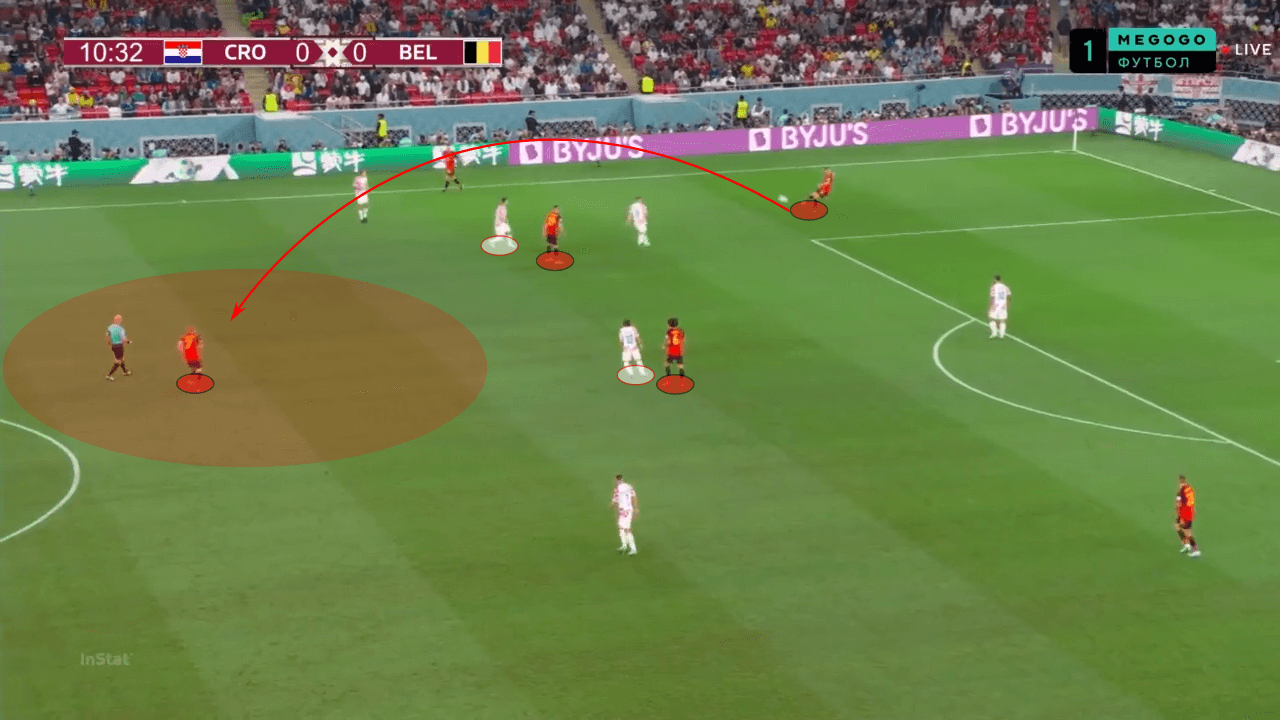
Out of possession, Belgium reverted to a 4-3-2-1 structure. Now with five players in the midfield, they were once again able to create numerical superiority over Croatia’s trio. While this did limit the damage Croatia’s midfielders were able to do with the ball, it certainly did not eliminate it. Often throughout the match, Modrić showed moments of brilliance to overcome such difficult scenarios.
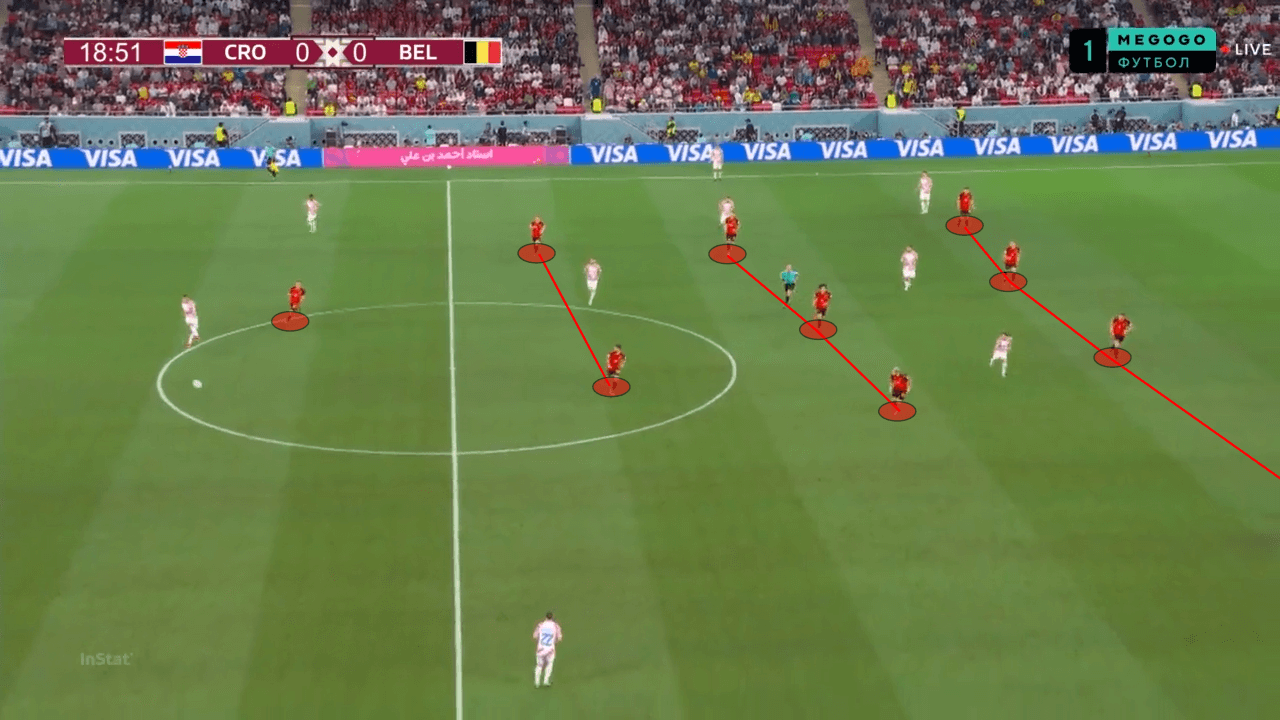
This defensive organisation not only allowed Martínez’s men to compactly defend the middle of the park, but it also proved to be quite dynamic when Croatia focused on the wide areas. Either wide midfielder in the bottom three was able to quickly jump out to the opposition’s fullback as the block compactly shifted over.
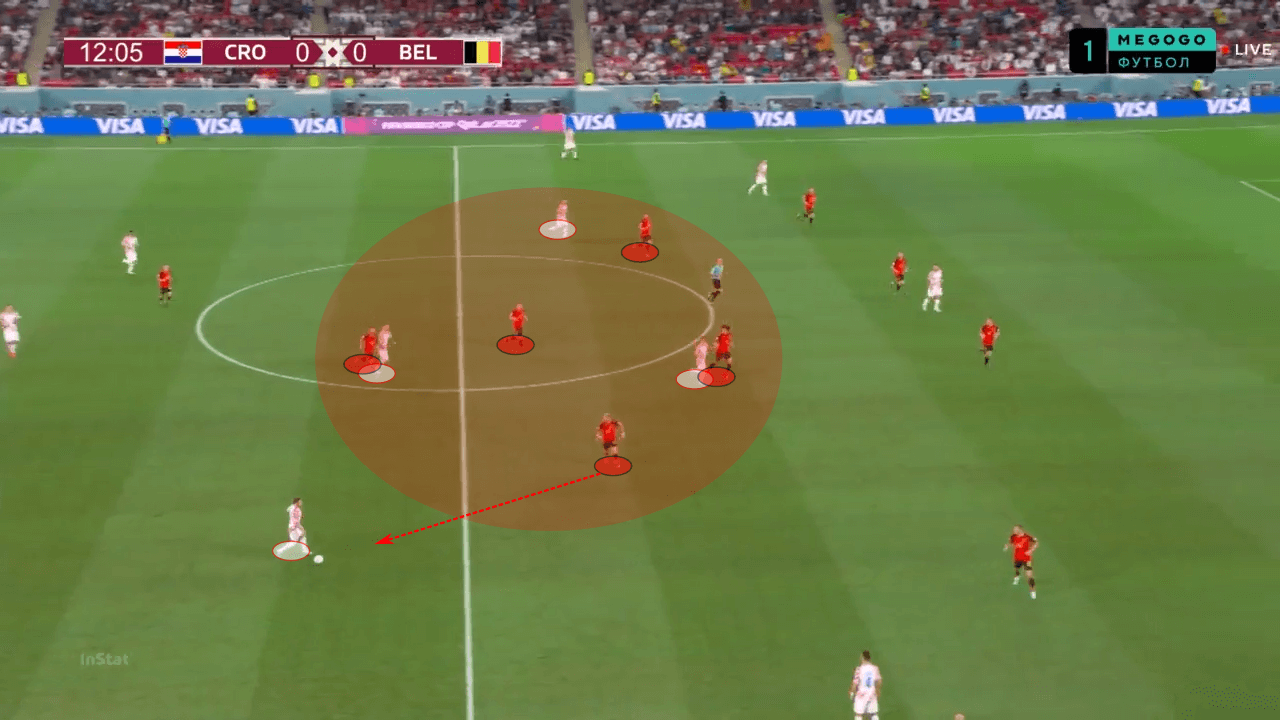
Inoffensive possession
As Belgium progressed into the middle third, however, they seemed to run out of ideas. Martínez’s tactics, especially in possession, have been riddled with problems recently. There is a lack of purpose to their possession, with static players and inoffensive actions. Most of their chances, at least in the first half, came from attacking transitions instead. This underwhelming attacking system was once again on display against Croatia.
Before looking at their shortcomings though, Dalić’s defensive system deserves some credit. Regardless of the height of their defensive block, Croatia were consistently effective in keeping Belgium from progressing with danger. This of course began in a high block, where they looked to disrupt Belgium’s possession from its roots.
Through intensity and coordinated movements, they were constantly able to congest the pitch, eliminate passing options, and overwhelm their opponents into playing it long. In the instance below, the left-back pushes up to join the left-wing, centre-forward, and two midfielders, in pressing Belgium’s build-up on the right.
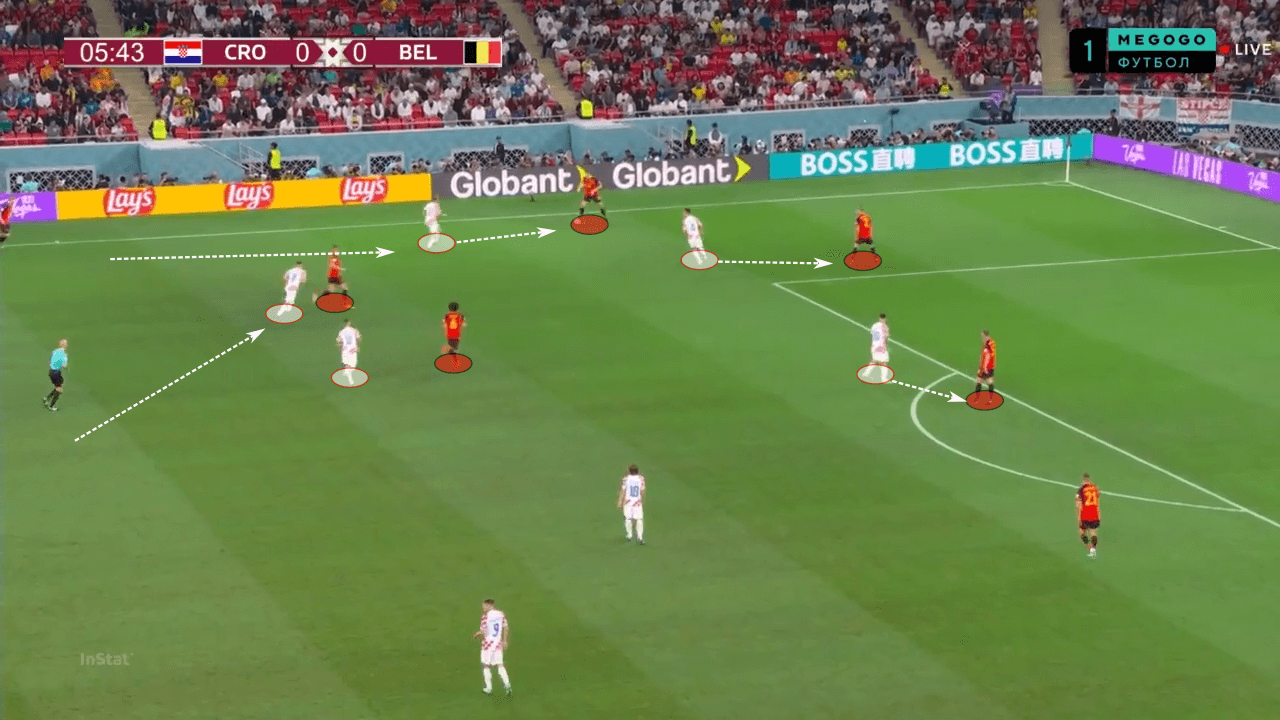
When reverting to a mid-block, Dalić’s front three remained extremely compact and narrow as they sat in front of Belgium’s midfield. Rather than pressuring Belgium’s centre-backs, they allowed them to have the ball and closed off the midfielders instead. This created a block of six players in the central area and kept Belgium from progressing most of the time.
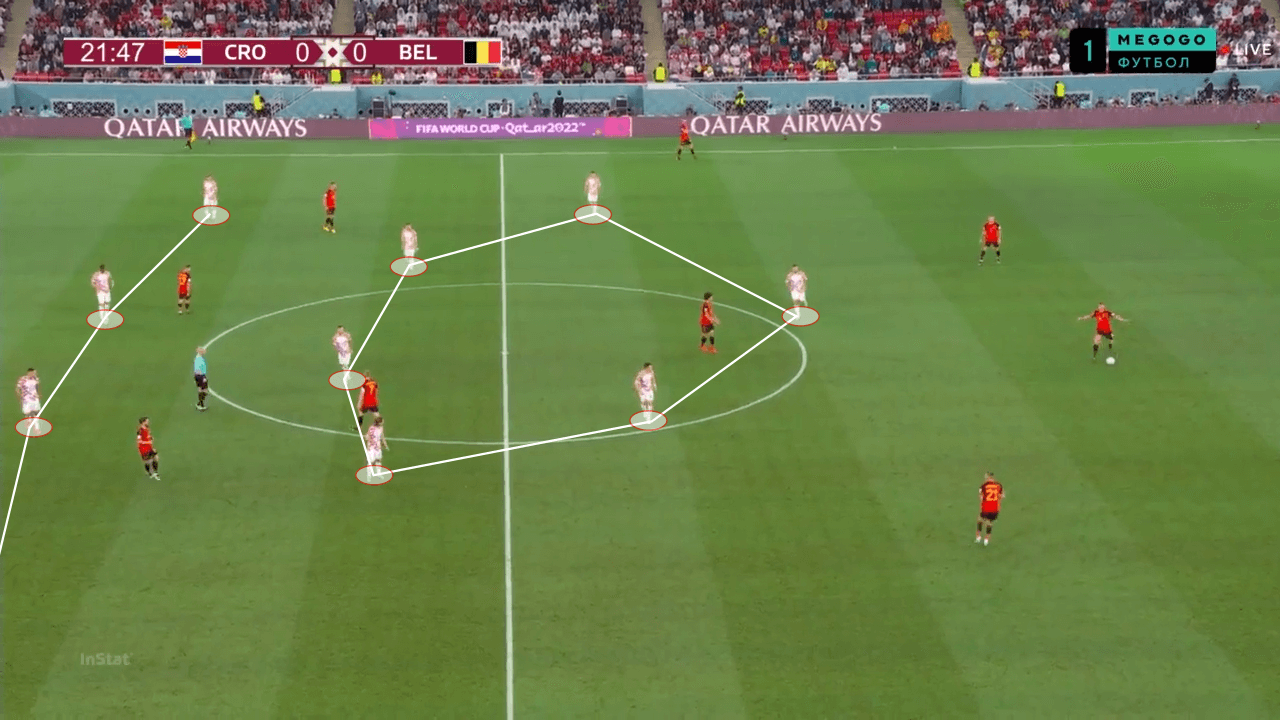
Finally, in lower blocks, they reverted to a 4-5-1 with both wingers tracking Belgium’s wing-backs. Their midfield was extremely effective in staying near the backline and limiting the space between the defensive lines, which Belgium often looked to exploit. Overall, this low block proved to be secure and dynamic as the Red Devils tried to break it down.
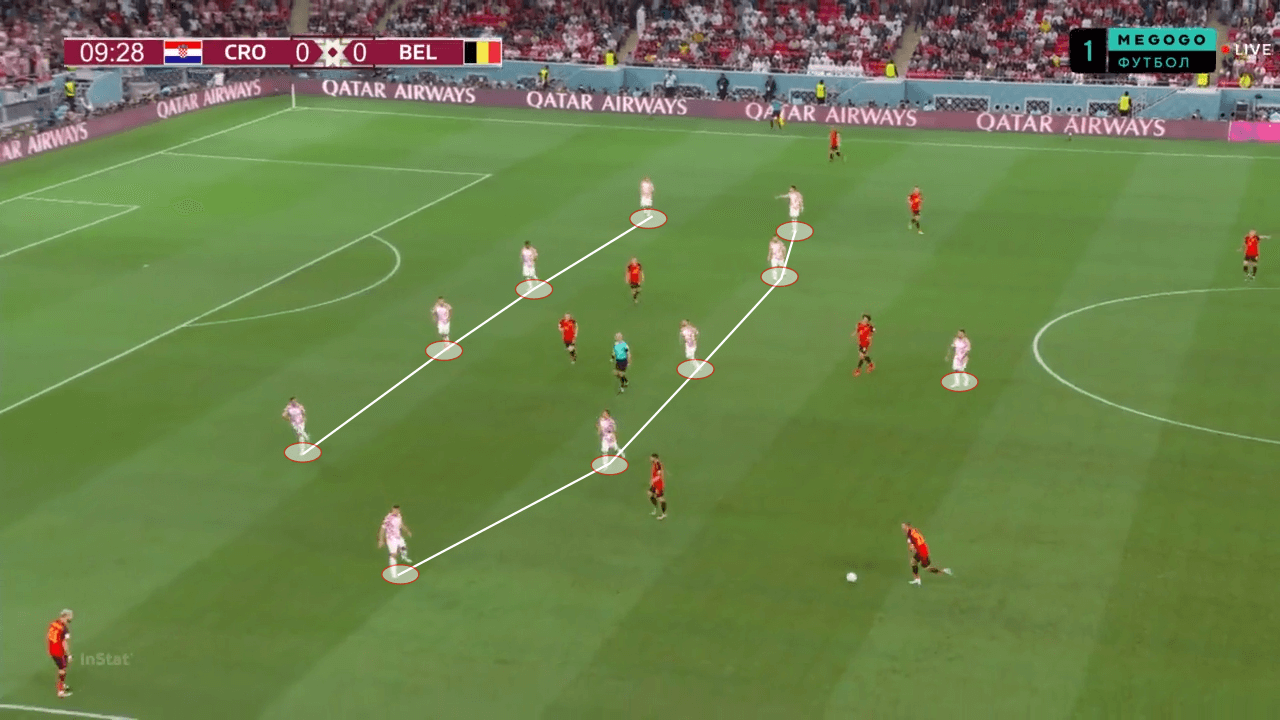
When forced to go wide, Belgium rarely had success. As their players were focused on the central lanes, they struggled to exploit the wide areas with success. In the instance below, as Modrić shifts over, Croatia have a 3v2 superiority in that channel. This was often the case in this phase of possession, resulting in an endless recycling of the ball from Martínez’s men.
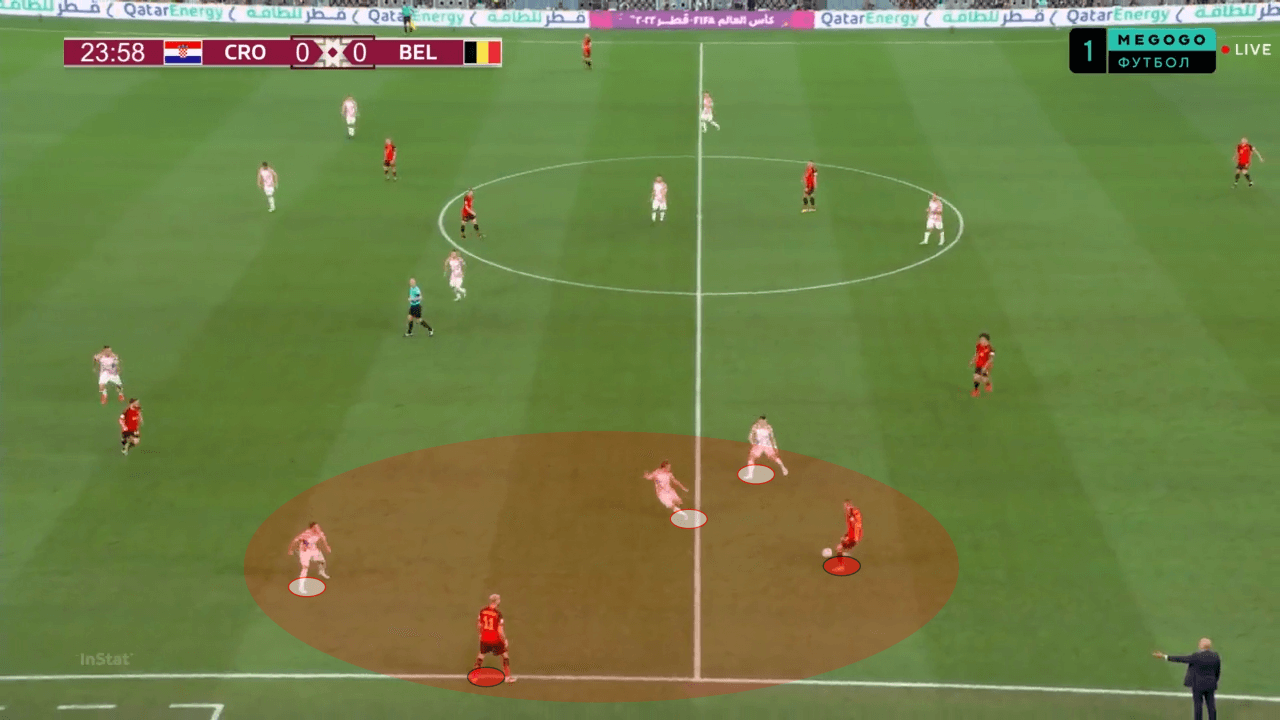
There was also a significant lack of mobility within Belgium’s attacking organisation. Martínez’s men seemed quite content with maintaining their structure, rather than using it to manipulate Croatia’s organisation and progress forward. Their static organisation and lack of positional movements resulted in very boring spells of possession, without much creation of space or progression of the ball.
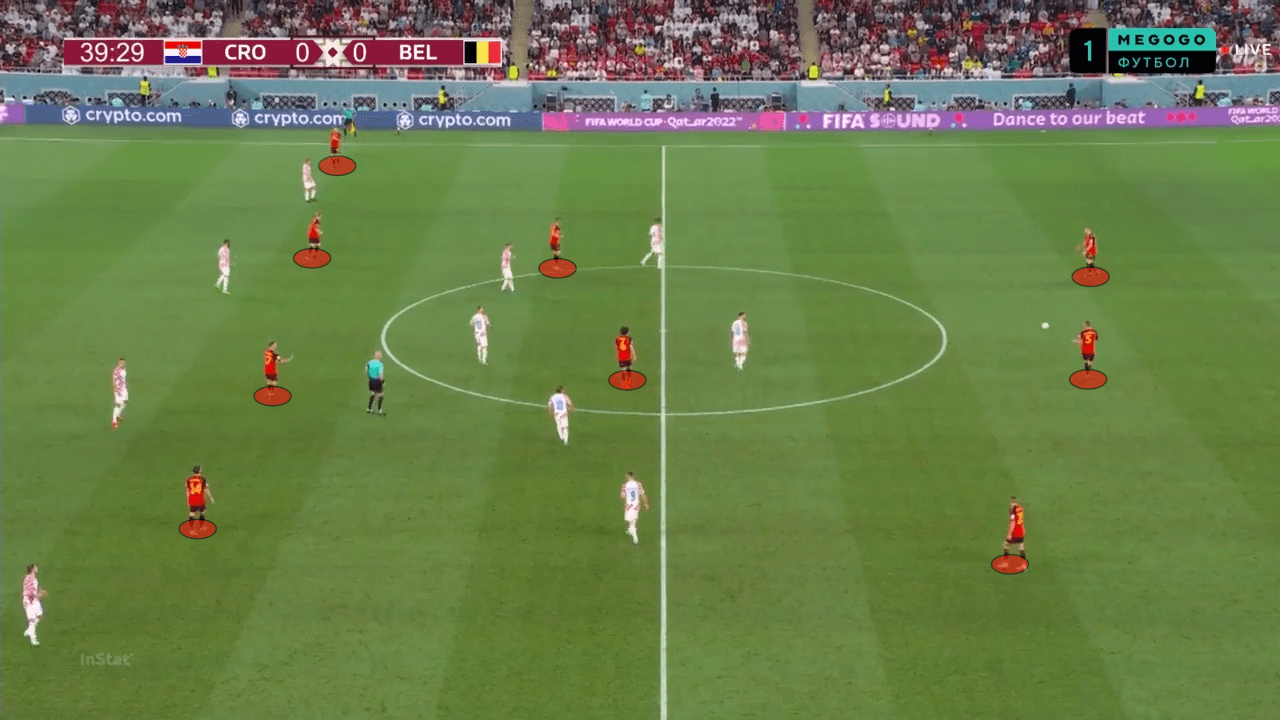
Finally, the lack of a true number nine proved to be a real problem in the first half. Without a centre-forward to manipulate the backline and ensure depth, Croatia’s back four were easily able to limit the spaces between lines and keep Belgium from reaching the final third. Mertens, Trossard, and De Bruyne all had rather undefined roles, with nobody performing any specific role well.
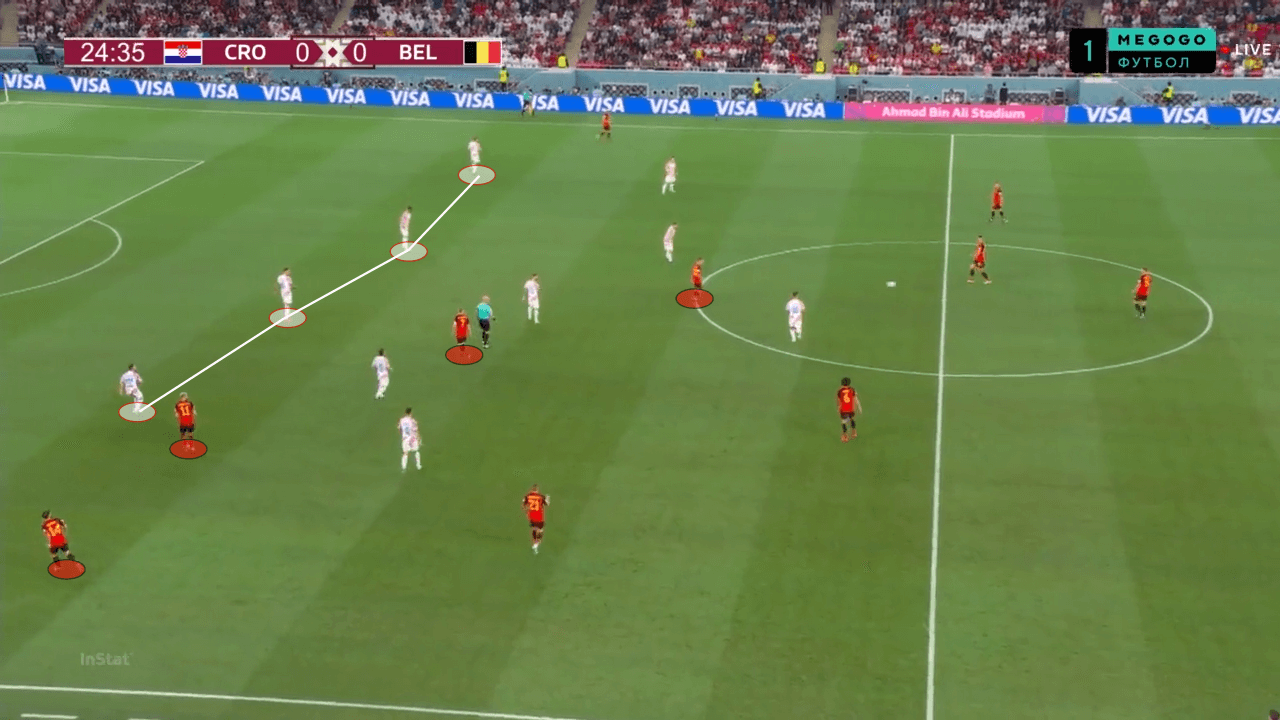
Romelu Lukaku’s introduction at half-time drastically changed this dynamic in the second half and allowed the Red Devils to create significantly more. In the instance below, for example, his presence among Croatia’s backline increases the depth of Belgium’s structure and allows for De Bruyne to find space between the lines.
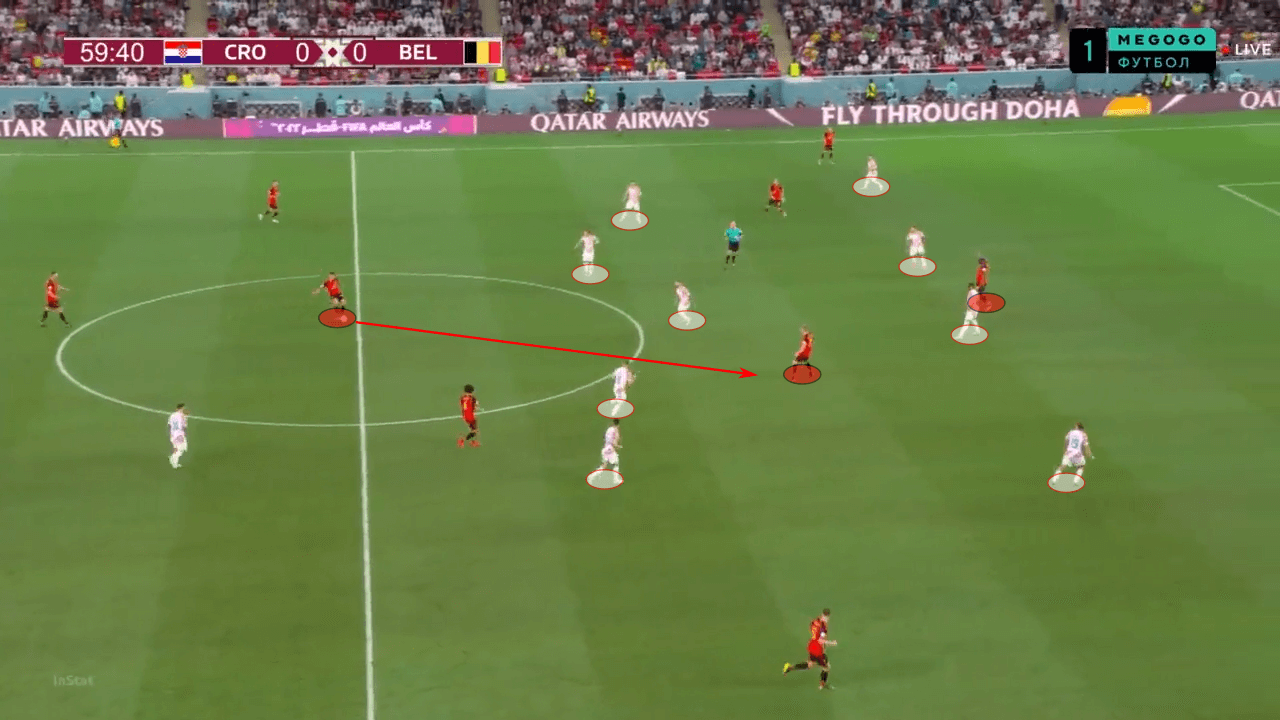
In another instance, his presence provided Belgium’s players with someone to work towards. Carrasco and De Bruyne often found success playing Lukaku inside before linking up with him further. Without him, there was a lack of passing options in the attack. Although the Inter centre-forward missed some big chances, his tactical role allowed them to create quality chances with much more frequency.
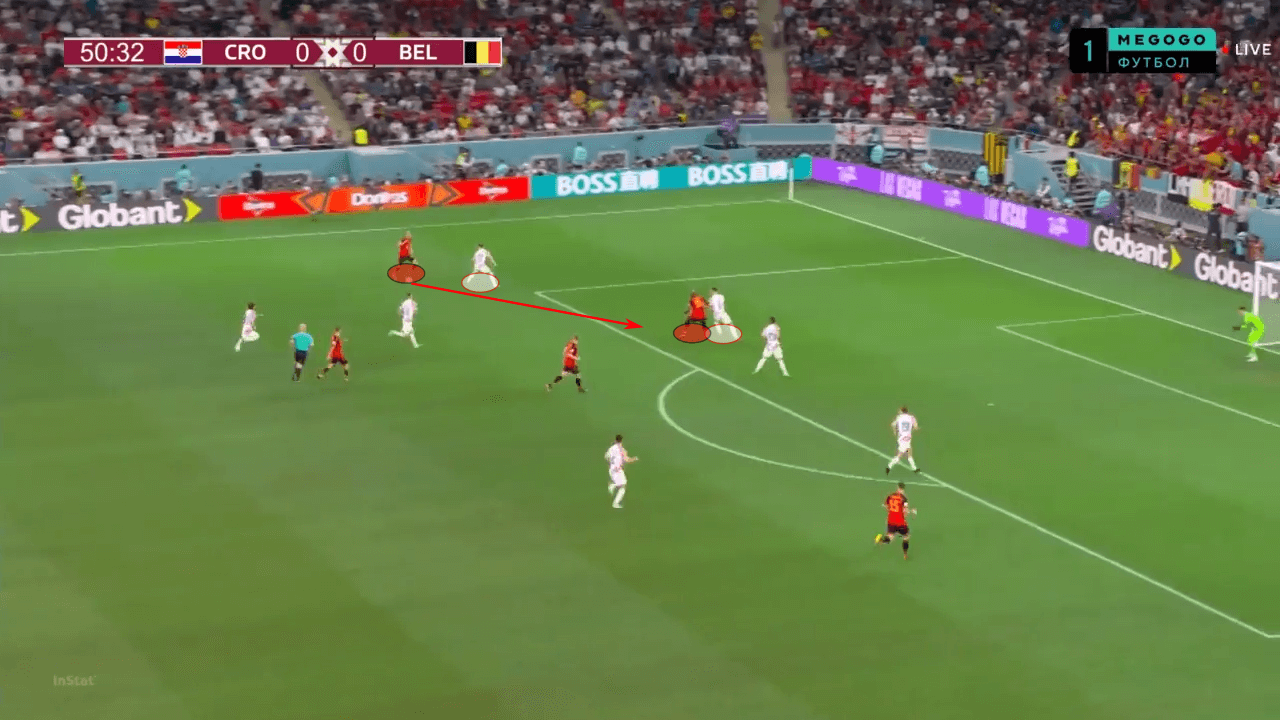
Conclusion
The match between Belgium and Croatia had an interesting tactical battle, but not many chances to show for it. While Croatia seemed quite content with a draw, Belgium did not show much urgency to fight out of elimination. The end result was an underwhelming 0-0 between the two big nations. The disappointing performance from the Red Devils saw their World Cup run come to an end, and Roberto Martínez’s project with the RBFA was finally terminated.
The new cycle will prove to be a fresh start for Belgium, with a new generation and a new manager. As for Croatia, Dalić’s men remain strong in the competition as they will face Japan in the Round of 16. While the final score was 0-0, the result was very different for both nations.





Comments